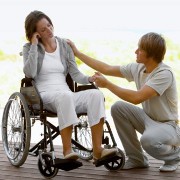 Photo: Getty Images
Photo: Getty Images
Osteoarthritis, the most common type of arthritis, involves the degeneration or break down of the cartilage in the joints. Aging, obesity and joint injury are contributing factors.
Rheumatoid arthritis is considered an autoimmune disease while osteoarthritis is a degenerative joint disease. Normally, our immune system fights off harmful foreign substances such as a virus and bacteria. In the presence of an autoimmune disease, the immune system mistakenly recognizes healthy tissue as foreign and attacks itself.
Osteoarthritis causes pain, swelling and limited motion in any joint in your body, but most often occurs in the hands, knees and weight-bearing joints like the hips or spine. Rheumatoid arthritis is a chronic disease that causes inflammation in the joints, surrounding tissue, and even other organs. Usually joints on both sides of the body are affected equally. The most commonly affected joints include the wrists, fingers, knees, feet and ankles.
The pain associated with osteoarthritis is typically less intense in the morning than in the afternoon or evening and occurs during and after movement. The pain, swelling and joint stiffness associated with rheumatoid arthritis is characteristically most severe in the morning, often felt on both sides of the body and can last for more than one hour. The joints can become warm, stiff and tender when not used for less than one hour.
Osteoarthritis results when the cartilage that covers the ends of the joint bones deteriorates. The usually smooth surface of cartilage becomes rough, thus causing irritation. Without the protective cushion of cartilage, bone rubs against bone. The ends of the bones become damaged causing pain, tenderness, swelling and eventually, limited range of motion. The cause of rheumatoid arthritis is unknown. Infection, genetics, and hormones may possibly contribute to this autoimmune disease.
Women, older adults, individuals who are born with bone deformities and those who have had a bone injury are at higher risk for developing osteoarthritis. Obesity, a job that places repetitive stress on a particular joint and other diseases such as rheumatoid arthritis, gout and Paget’s disease of the bone are additional risk factors. Rheumatoid arthritis can occur at any age, but most commonly begins between the ages of 40 and 60. Women tend to develop rheumatoid arthritis more often than men. Though not considered to be a genetic disease, having a family history of rheumatoid arthritis increases your risk. Smoking cigarettes is another risk factor.
Osteoarthritis is a progressive and disabling degenerative disease. The severity of pain and joint stiffness can have a negative impact upon a person’s ability to work and manage the activities of daily living. In severe cases, joint replacement surgery is necessary. Rheumatoid arthritis causes debilitating and disfiguring joint damage. Joint damage can severely interfere with performing daily activities. In severe cases, a person can no longer perform daily activities.
There is no cure for osteoarthritis or rheumatoid arthritis. The use of medications such as acetaminophen, tramadol and cortisone, along with physical therapy, can help reduce the pain associated with osteoarthritis. Ibuprofen, naproxen and prescription strength versions of these drugs reduce inflammation and relieve pain.
In cases of severe pain, narcotics such as codeine may be prescribed but these drugs carry a risk of dependence. Usually, the treatment for rheumatoid arthritis requires a lifelong regime of medication, physical therapy, exercise, education and possibly, surgery. Disease modifying antirheumatic drugs or DMARDs, non-steroidal anti-inflammatory drugs or NSAIDs, corticosteroid drugs, immunosuppressant medications and TNF-alpha inhibitors are used to treat rheumatoid arthritis. Many of these medications have potentially serious side effects.
Physicians typically prescribe drugs with the fewest side effects first. Occupational therapy focuses on helping a person find ways to perform tasks while reducing stress on painful joints. If medications fail, surgery, such as total joint replacement, may be necessary.
Sources
Medline Plus: Osteoarthritis
http://www.nlm.nih.gov/medlineplus/osteoarthritis.html
PubMed Health: Rheumatoid Arthritis
http://www.ncbi.nlm.nih.gov/pubmedhealth/PMH0001467/
The American Association of Chronobiology and Chronotherapeutics:
Chronobiology and Chronotherapeutics of Arthritic Diseases
http://www.aamcc.net/cap2.htm
MayoClinic.com: Osteoarthritis
http://www.mayoclinic.com/health/osteoarthritis/DS00019




